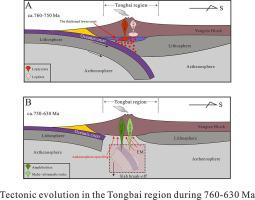Precambrian Research ( IF 3.2 ) Pub Date : 2021-05-12 , DOI: 10.1016/j.precamres.2021.106239 Pan-Pan Niu , Shao-Yong Jiang

|
Abundant metavolcanic rocks (leptynite, leptite, and amphibolite) occur in the Tongbai orogen, central China, but their age, origin, and tectonic significance are poorly constrained. Here we report geochemistry, zircon U–Pb ages, and Hf isotopes of these metavolcanic rocks to determine their petrogenesis and geodynamic implications. Our data indicate that all the leptynites, leptites, and amphibolites were initially formed at 760–720 Ma and then underwent later metamorphism. These rocks exhibit arc-related geochemical compositions characterized by enriched large ion lithophile elements and light rare earth elements and depleted heavy rare earth elements. Leptynites and leptites present similar characteristics, including high SiO2 (72.14–77.24 wt%), MgO (0.19–0.44 wt%), and Sr (239–827 ppm) compositions and low Y (6.9–16 ppm) and Yb (0.70–1.17 ppm), along with high Sr/Y and (La/Yb)N values. The leptynites exhibit no or slightly negative Eu anomalies in both the whole-rock and zircon. Based on the high K2O (3.75–4.31 wt%) and slightly lower Al2O3 (<15 wt%) contents, as well as high ε(Hf)t values (−0.53 to 5.80), the leptynites conform to C-type adakites and were possibly derived from partial melting of the thickened juvenile mafic lower crust. The leptites demonstrate a distinct negative Eu anomaly and low εHf(t) values of −13.19 to −6.60, implying an ancient middle–lower crustal source. In contrast, the amphibolites exhibit lower SiO2 (52.62–53.33 wt%) and higher MgO (3.88–4.32 wt%) contents, as well as higher Y (19.5–30.0 ppm) and Yb (1.89–3.26 ppm) concentrations, indicating of island arc volcanic rocks. Furthermore, the higher Mg# (31–35), Cr (14–18 ppm), V (200–272 ppm), and Ni (37–59 ppm) contents of the amphibolites indicate more substantial amounts of mantle components in their magma source. The variable zircon εHf(t) values from −10.1 to 1.95 in the amphibolites suggest an enriched mantle source. Based on these new data, we propose that the Tongbai region underwent a continuous oceanic subduction before 750 Ma, followed by a subducted slab break-off during 750–720 Ma, which is inconsistent with the previously proposed single slab break-off model for the South Qinling region











































 京公网安备 11010802027423号
京公网安备 11010802027423号